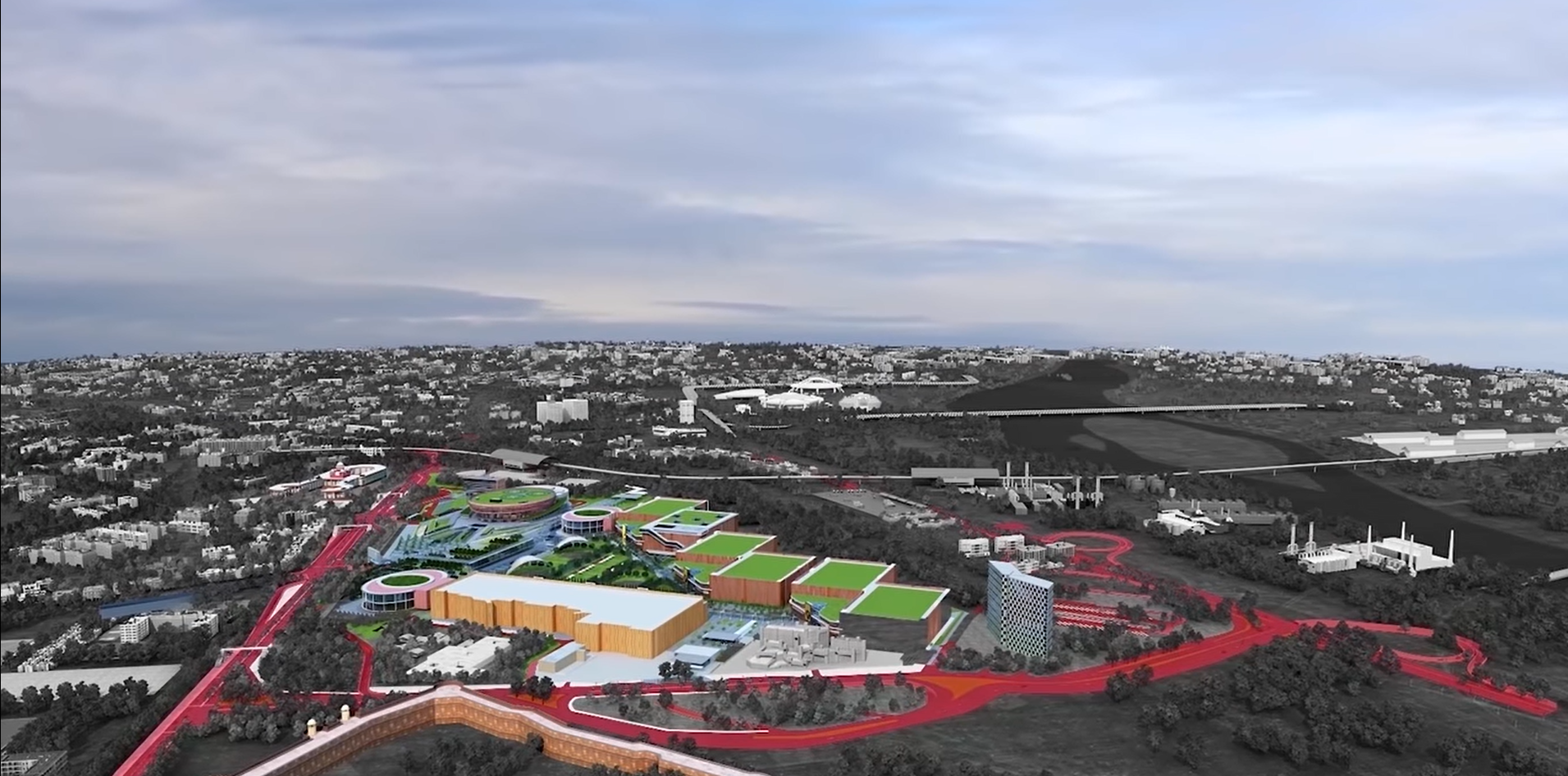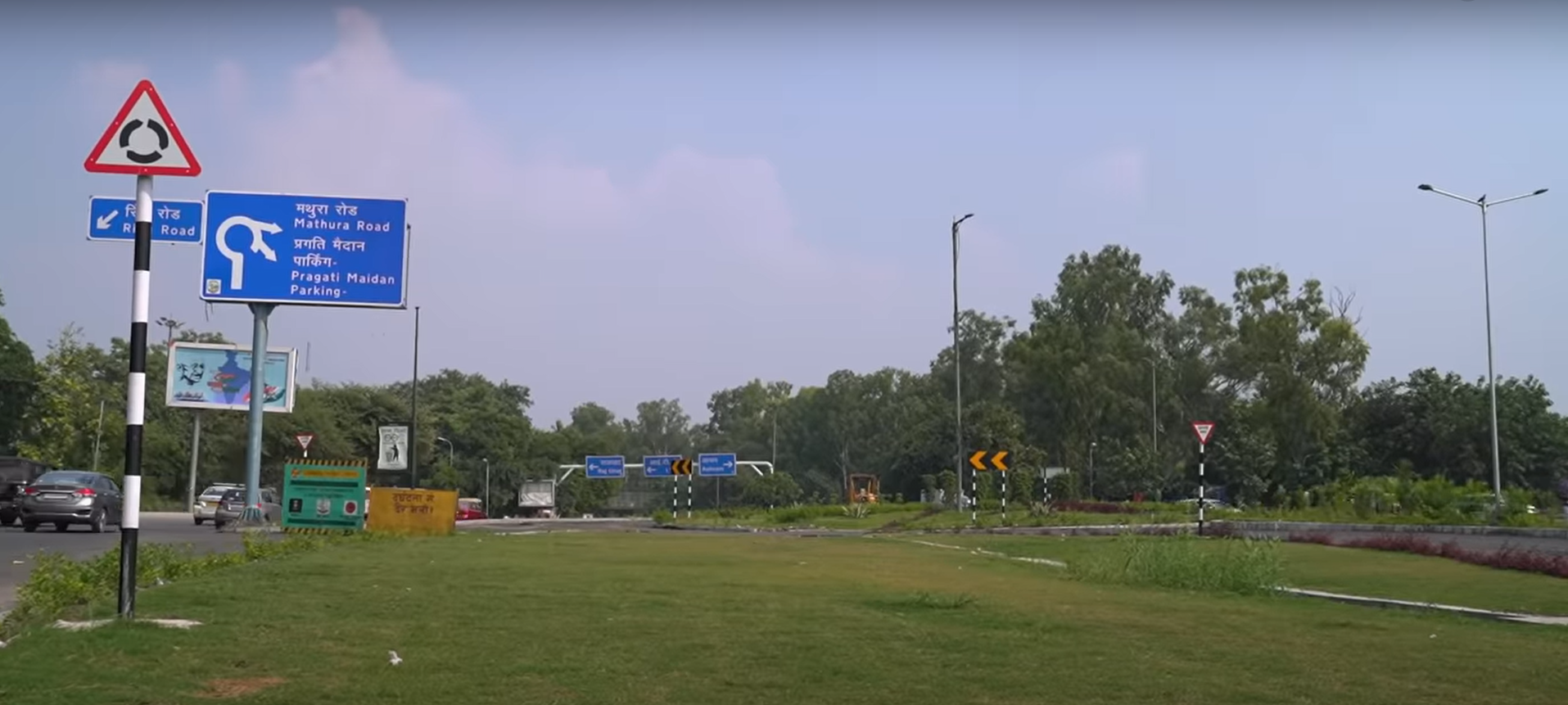
The Pragati Maidan Integrated Road Project was planned by the government as part of the plan for improvement of transport movement in the Ring Road, Bhairon Marg, Mathura Road sector through the development of a capacity compatible tunnel that is about 1.6 km long. The proposed project was aimed to decongest the traffic around Pragati Maidan area when ITPO convention centres operate at full capacities. The transit corridor aims to connect India Gate to Ring Road starting at Purana Qila. The construction has been done with the objective of removing some traffic signals and allowing for smooth passage of vehicles.
The project besides reducing congestion and smoothening traffic flow is expected to also provide co-benefits in the form of reducing the pollutant load in the localised area and contribute to GHG reductions. The Government of India has made several efforts to reduce its energy intensity and implement projects to address the issue of CO2 emissions. The ITPO project contributes to the government’s endeavours in supporting this further.
Based on the preliminary studies and data collected from various sources, it can be deduced that construction of this tunnel will contribute to travel time savings to the tune of 8 minutes per vehicle. Based on this aspect, brief information note details the CO2 savings that can be achieved and other benefits that might accrue.
Project Information – infrastructure and transport
The mega infrastructure project aims to improve the transit time for commuters using the stretch. The project involved construction of six underpasses on Mathura Road, Bhairon Marg, and Ring-Road-Bhairon Marg intersection. A major six-lane tunnel covering 1.6 km has also been constructed under the project, which crosses under multiple railway lines. There is also a provision of a tunnel connecting two sides of the Pragati Maidan Convention Centre for car parking, under the main tunnel. Besides, the project involves multiple facilities to streamline traffic movement and reduce congestion by reducing the number of traffic signals.

Transport - Baseline and post project traffic status
The sheer volume of traffic reported on the corridor is huge. As per the baseline study, the average daily traffic volume recorded for different stretches on the project corridor varied between 14,211 passenger car units (PCUs) on the Subramanian Bharti Marg and 1,46,827 PCUs on the Ring Road. The latter is the main arterial road and witnesses extremely high volume of traffic.
PCU consideration under the Project
| S no. | Vehicle Type | PCU |
|---|---|---|
| 1 | 2-Wheeler | 0.75 |
| 2 | 3-Wheeler- Auto | 2.0 |
| 3 | Car/Jeep/Van | 1.0 |
| 4 | Truck/Bus | 3.7 |
| 5 | LCV | 2.0 |
| 6 | Tractor with Trailor | 4.0 |
In terms of vehicle mix, private cars and two-wheelers account for a major share of between 70% and 80%. Before the project started, the turning locations were characterized by major congestion and choke points. In particular, the Bhairon Marg-Ring Road intersection reported the maximum traffic of 1,89,081 PCUs per day followed by Mathura Road-Bhairon Marg intersection at 1,55,158 PCUs per day and Mathura Road-Shershah Road intersection at 1,38,640 PCUs per day.
Consequently, the high traffic volume count resulted in congestion and higher journey time. Some of the key reasons highlighted in the detailed project report were halting delay, traffic signals, and pedestrian crossing.
Average Daily Traffic Volume at Important Locations of the Project Corridor (2017)
| Location | Total PCUs (per day) |
|---|---|
| Ring Road | 1,46,827 |
| Bahadur Shah Zafar Marg | 99,807 |
| Bhairon Marg | 82,165 |
| Shershah Road | 74,419 |
| Tilak Road near bus stop | 52,610 |
| Purana Quila Road | 50,717 |
| Pragati Maidan Gate No. 7 | 47,360 |
| Sikandra Road Metro Pillar No. 3 | 45,671 |
| Subramanian Bharti Marg | 14,211 |
The capacity of these road stretches and intersections was the limiting factor while catering to high traffic volume resulting in higher transit time. Also, due to lack of multi-modal and first-mile and last-mile connectivity, and over-crowding of metro during peak hours, the share of Delhi Metro in the total traffic is limited and stagnant. The project was envisaged to resolve such issues by providing seamless connectivity to the non-motorized traffic, pedestrian movement and intermediate public transport (IPT) solutions such as three-wheelers and taxis.
While undertaking traffic projection exercise for the project area for different types of vehicles, the share of taxis involved higher growth rate as compared to cars and two-wheelers, which is expected to taper down between the base year 2016 and horizon year 2023 as indicated in the DPR while developing the plan for the construction.
Growth of Segment-wise Traffic Increase on Year-on-Year basis (%)
| Year | Car | Two-Wheeler | Three-Wheeler | Taxi | Bus | Commercial |
|---|---|---|---|---|---|---|
| 2016 | 5.2 | 5.0 | 2.4 | 8. 7 | 3.7 | 4.0 |
| 2017 | 5.0 | 4.8 | 2.4 | 8.0 | 3.2 | 4.0 |
| 2018 | 4.8 | 4.6 | 2.4 | 7.4 | 3.0 | 4.0 |
| 2019 | 4.5 | 4.3 | 2.3 | 6.7 | 2.8 | 4.0 |
| 2020 | 4.0 | 3.8 | 2.1 | 5.8 | 2.7 | 4.0 |
| 2021 | 3.9 | 3.7 | 2.0 | 5.5 | 2.7 | 4.0 |
| 2022 | 3.8 | 3.6 | 2.0 | 5.2 | 2.6 | 3.6 |
| 2023 | 3.5 | 3.4 | 1.9 | 4.8 | 2.6 | 3.6 |
Based on the traffic flow, volume, road carrying capacities, congestion level and higher travel time for the commuters while using the old road infrastructure, the Government of India decided to revamp and rebuild the intersections and road infrastructure in and around Pragati Maidan. The project not only eases the traffic condition for commuters travelling between Ring Road and India Gate, but also to those visiting the Pragati Maidan’s India Trade Promotion Organization (ITPO) facility.
Transport and Climate Change
Transport sector accounts for the largest share in total emissions in India. The sector is already responsible for emitting around 23% of the energy-related CO2 that feeds global warming. Nearly 85% of total diesel consumption of 77 million tonnes and 100% of the total petrol consumption of 31 million tonnes, is used by the transport sector. During the last two decades, India’s oil demand from the road transport sector has recorded the highest growth in the world, resulting in high import dependency and India’s foreign exchange outflow.
As a global ambition to reach Net Zero emissions by 2050 and comply with the 1.5 degrees Celsius target, the goal for transport sector should be to decarbonize and move from 7.7-gigatonne (Gt) emissions/year down to 2-3 Gt by mid-century, instead of a business-as-usual (BAU) scenario, which accounts for emissions increase to 13–15 Gt by 2050. In the BAU scenario, Indian transport sector could be responsible for around 1.5 Gt of annual carbon emissions by 2050.
It becomes necessary for the transport sector to achieve a sectoral target in order to reach a Net-Zero target by 2050. As per the Nationally Determined Contribution (NDC) under the Paris Agreement, India has committed to reduce the emission intensity of its gross domestic product by 33% to 35% from 2005 levels by 2030, which has been increased to 45% by our Hon’ble Prime Minister at COP26 in Glasgow 2021. The Government has defined emission reduction targets for renewable energy and power generation, but there are many other sectors that lack such sectoral targets, and transport is one.
There are multiple emission mitigation strategies to decarbonize the transport sector and eventually reduce its impact on climate change. TERI analysis indicates that modal shift of passenger and freight traffic to efficient modes of transport and improvement in efficiency of vehicles by enhancing engine technology, reducing congestion, etc. will contribute significantly in reducing emissions and improving city’s air quality[1]
The Pragati Maidan Integrated Road Project aims to decongest a critical corridor in the city of Delhi and has multiple benefits. These include:
- Decongestion, reduced choking points and smoothening of traffic flow
- Reduced pollution loads in the region impacting air quality locally due to smooth flows of traffic and reduction in traffic signals. This can be determined by amount of time spent by vehicles in the stretch, pre and post implementation
- Secondary and tertiary order impacts of the project on the total fuel spent, savings on fuel at the consumer end, linkages with driving stress and health can be drawn.
- As per the detailed project report for the proposed project, the total number of vehicles passing through the identified stretch is 1,14,000 PCUs per day. Taking vehicle classification as mentioned below, weighted average of Occupancy/PCUs is 2.15.
With regard to key parameters related to travel time savings and emissions, based on the baseline scenario as per the DPR developed, are given below.
- It is estimated the “expected average time savings for the vehicles to pass through the identified stretch would be 8 minutes”
- Total fuel (petrol equivalent) savings per car would be 600 milliliters per vehicle per hour leading to an overall fuel savings is estimated to be 54,90,240 liters/year
- Corresponding CO2 savings is of 12,400 tonnes/year[2]
- As per Delhi Transportation Department, from project concept to implementation, there is an increment of 4% in transportation volume which corresponds to carbon savings of 16,400 tonnes of CO2, when the project gets commissioned in 2022.
Carbon reduction prices in the current international market are in upward trend and with a conservative estimate of 6 USD per tonne of CO2 savings, this project intervention could generate annual revenue to a tune of approximately INR 70 Lakhs.
Way forward
India is a signatory to the Paris Agreement and has its commitments with regard to GHG reductions and improving of its overall emissions intensity. Besides India also leads the initiative on the Clean Air Programme. Transportation sector interventions contribute directly to the emissions savings. Detailed project related surveys and analysis can be carried out assisting in quantifying and substantiating the above figures. In addition, the outcome of this intervention could be developed as a project activity and monetized under carbon credit market initiatives.
There is a strong need to link every development project with multiple benefits as outlined above and undergo baseline assessments and post-project assessments on the overall benefits that the project might accrue thereby contributing to India’s goals helping in meeting its targets.
There is also an important intervention in improving the public transport system in Delhi and other cities, including first and last-mile connectivity to the metro stations and bus stops. Importantly, provision for pedestrians and non-motorized traffic, as done in the Pragati Maidan Integrated Road Project in consultation with UTTIPEC[3], should be made part of all the future transport infrastructure projects in Indian cities.
Footnotes
[1]https://www.teriin.org/sites/default/files/files/Decarbonization_of_Transport%20Sector_in_India.pdf
[2]TERI estimate 2022, based on the DPR and available data sources. Emission factor of 2.27 kg CO2; “India GHG Program- India Specific Road Transport Emission Factors, 2015”
[3]Unified Traffic and Transportation Infrastructure Centre
